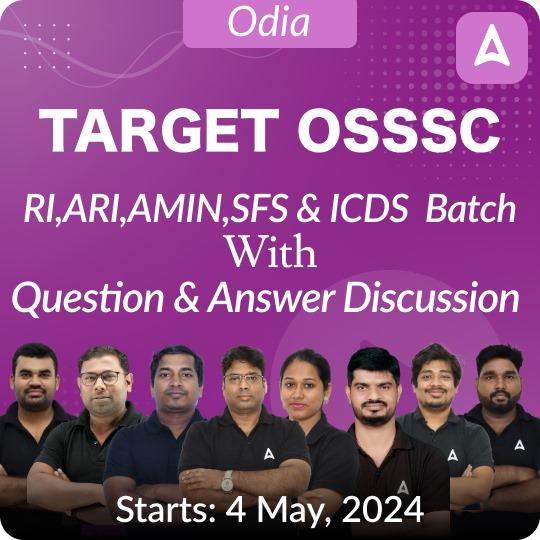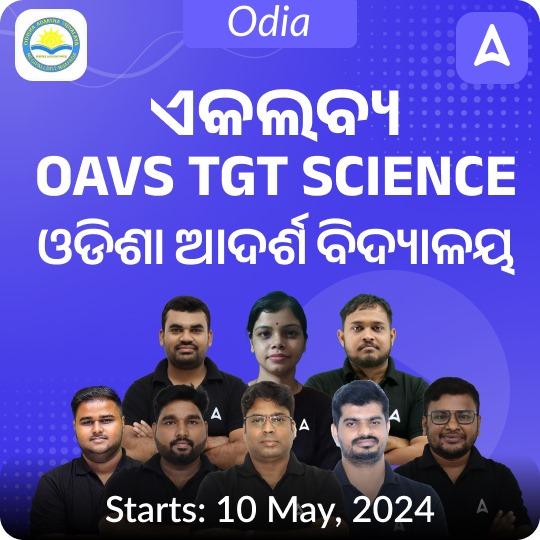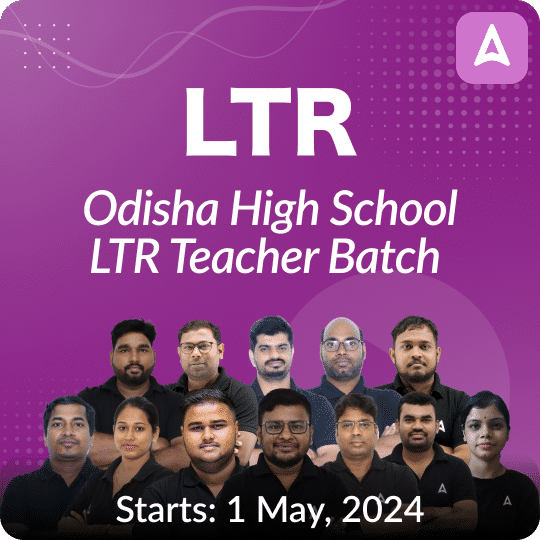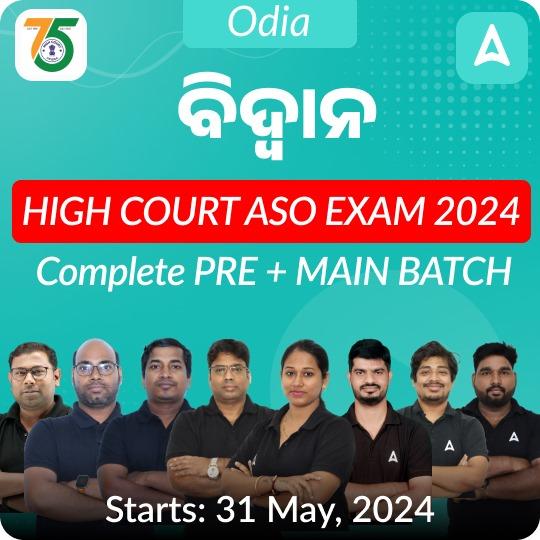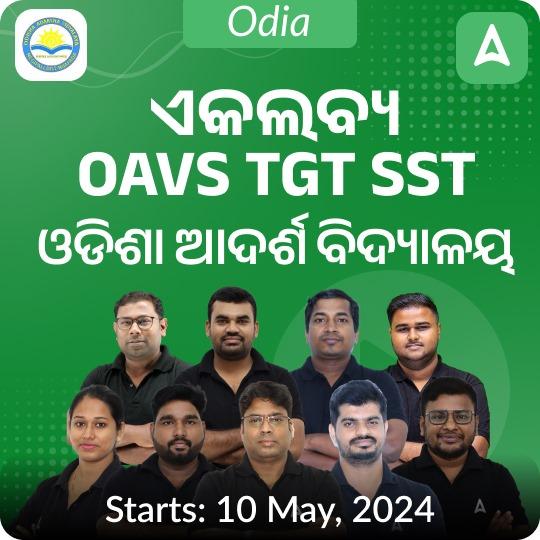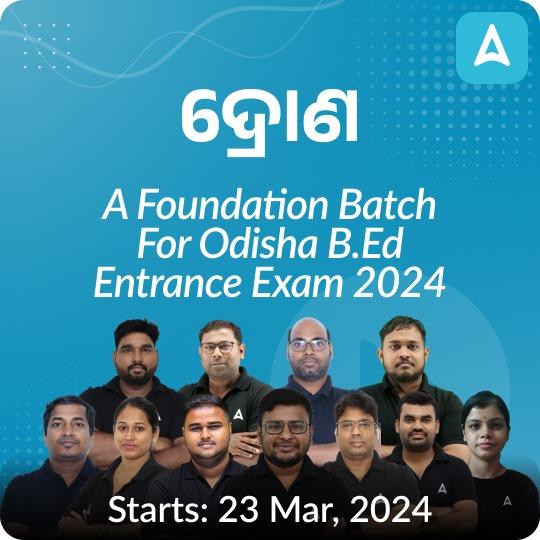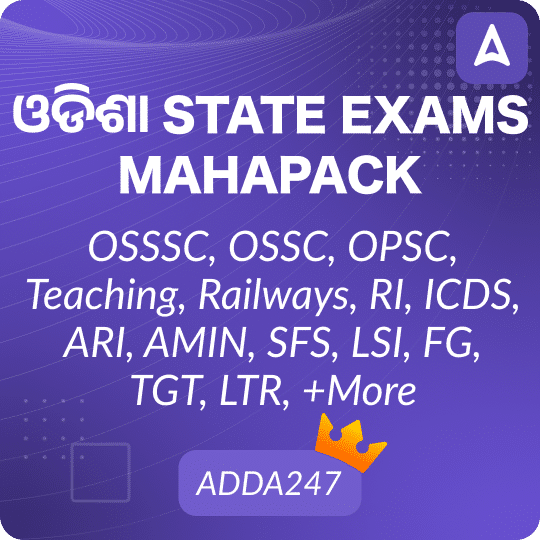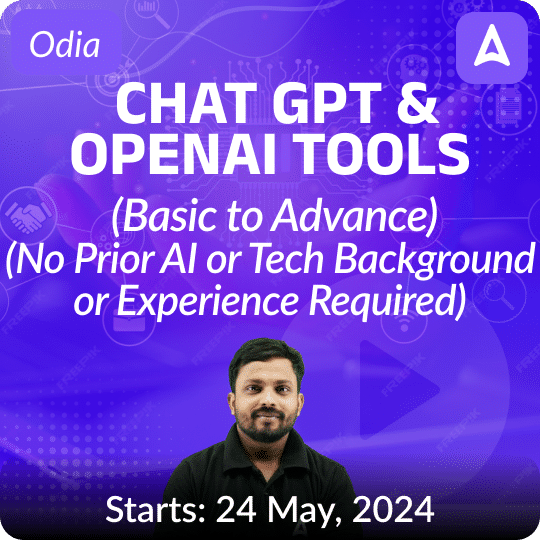Weekly Current affairs play a very important role in the competitive examinations and hence, aspirants have to give undivided attention to it while doing preparation for the government examinations. The CGLRE, OCS examinations comprise a section of “Current Affairs” to evaluate how much the aspirant is aware of the daily happenings taking place around the world. To complement your preparation, we are providing you with a compilation of Weekly Current affairs.
- Who was awarded the 2024 Ramanujan Prize? (a) Akshay Venkatesh
(b) Ruochuan Liu
(c) Cédric Villani
(d) Terence Tao
Ans: (b) Ruochuan Liu
Explanation: Ruochuan Liu, a distinguished expert in p-adic Hodge theory from Peking University, China, was awarded the 2024 Ramanujan Prize. - Which of the following organizations administers the Ramanujan Prize? (a) World Bank
(b) United Nations
(c) International Centre for Theoretical Physics (ICTP) and International Mathematical Union (IMU)
(d) World Health Organization
Ans: (c) International Centre for Theoretical Physics (ICTP) and International Mathematical Union (IMU)
Explanation: The Ramanujan Prize is administered jointly by the ICTP and IMU. - What is the maximum age limit for eligibility for the Ramanujan Prize? (a) 35 years
(b) 50 years
(c) 45 years
(d) 40 years
Ans: (c) 45 years
Explanation: The prize is awarded to researchers under the age of 45 as of December 31 of the award year. - How much is the cash award for the Ramanujan Prize? (a) $20,000
(b) $10,000
(c) $15,000
(d) $5,000
Ans: (b) $10,000
Explanation: The Ramanujan Prize includes a cash award of $10,000. - How many new geoglyphs were discovered near the Nazca Lines using AI? (a) 150
(b) 303
(c) 500
(d) 200
Ans: (b) 303
Explanation: Archaeologists uncovered 303 previously unknown geoglyphs using artificial intelligence. - Which university’s research team discovered the new geoglyphs? (a) Harvard University
(b) University of Tokyo
(c) Yamagata University
(d) University of Cambridge
Ans: (c) Yamagata University
Explanation: The discovery was made by a team from Japan’s Yamagata University in collaboration with IBM Research. - The newly discovered geoglyphs near the Nazca Lines date back to approximately which period? (a) 300 BCE
(b) 500 BCE
(c) 200 BCE
(d) 100 AD
Ans: (c) 200 BCE
Explanation: The newly identified geoglyphs date back to approximately 200 BCE. - Which of the following subjects were depicted in the newly discovered Nazca geoglyphs? (a) Elephants
(b) Parrots and monkeys
(c) Tigers
(d) Sharks
Ans: (b) Parrots and monkeys
Explanation: The newly discovered geoglyphs depicted a variety of animals, including parrots, cats, monkeys, and killer whales. - Which country recently overtook Japan to become the third-largest power in the Asia Power Index? (a) China
(b) Australia
(c) India
(d) South Korea
Ans: (c) India
Explanation: India has overtaken Japan to become the third-largest power in the Asia Power Index. - Which institution launched the Asia Power Index? (a) Brookings Institution
(b) Lowy Institute
(c) International Monetary Fund (IMF)
(d) World Economic Forum (WEF)
Ans: (b) Lowy Institute
Explanation: The Asia Power Index was launched by the Lowy Institute in 2018. - Which of the following is NOT a resource-based determinant of the Asia Power Index? (a) Economic Capability
(b) Military Capability
(c) Diplomatic Influence
(d) Resilience
Ans: (c) Diplomatic Influence
Explanation: Diplomatic Influence is an influence-based determinant, not a resource-based one. - What unique feature allows sea robins to “walk” on the seafloor? (a) Tail fins
(b) Modified pectoral fins
(c) Dorsal fins
(d) Ventral fins
Ans: (b) Modified pectoral fins
Explanation: Sea robins have modified pectoral fins that function as legs, allowing them to walk on the seafloor. - In which research institution were the unique sensory abilities of sea robins first studied? (a) Scripps Institution of Oceanography
(b) Marine Biological Laboratory, Cape Cod
(c) Woods Hole Oceanographic Institution
(d) Monterey Bay Aquarium
Ans: (b) Marine Biological Laboratory, Cape Cod
Explanation: The unique sensory abilities of sea robins were first investigated by Corey Allard at the Marine Biological Laboratory, Cape Cod. - To which family do sea robins belong? (a) Triglidae
(b) Scorpaenidae
(c) Carangidae
(d) Serranidae
Ans: (a) Triglidae
Explanation: Sea robins belong to the family Triglidae, within the order Scorpaeniformes. - What type of environments are sea robins primarily found in? (a) Freshwater rivers
(b) Deep ocean trenches
(c) Temperate and tropical waters
(d) Polar seas
Ans: (c) Temperate and tropical waters
Explanation: Sea robins are found in temperate and tropical waters, often at depths up to 660 feet. - In which year was the Swachh Bharat Mission launched? (a) 2010
(b) 2012
(c) 2014
(d) 2016
Ans: (c) 2014
Explanation: The Swachh Bharat Mission was launched on October 2, 2014, by Prime Minister Narendra Modi. - What is the theme of Swachhata Hi Seva 2024? (a) Swachh Bharat, Swasth Bharat
(b) Clean India, Green India
(c) Swabhav Swachhata, Sanskaar Swachhata
(d) Hygiene for All
Ans: (c) Swabhav Swachhata, Sanskaar Swachhata
Explanation: The theme for Swachhata Hi Seva 2024 is “Swabhav Swachhata, Sanskaar Swachhata,” emphasizing collective responsibility for cleanliness. - What was the youth unemployment rate in Odisha for the year 2022-23?
(a) 11.1%
(b) 13.8%
(c) 10.2%
(d) 12.7%
Ans: (b) 13.8%
Explanation: The PLFS report indicates that the youth unemployment rate in Odisha for 2022-23 was 13.8%, which dropped to 11.1% in 2023-24. - How much did the youth unemployment rate decrease in Odisha according to the 2023-24 PLFS report?
(a) 1%
(b) 2%
(c) 3%
(d) 4%
Ans: (b) 2%
Explanation: The youth unemployment rate in Odisha decreased by 2%, from 13.8% in 2022-23 to 11.1% in 2023-24. - What is the national youth unemployment rate in India as per the 2023-24 PLFS?
(a) 11.1%
(b) 13.8%
(c) 10.2%
(d) 9.3%
Ans: (c) 10.2%
Explanation: The all-India average youth unemployment rate is 10.2%, according to the 2023-24 PLFS. - Which area in Odisha saw a significant decline in youth unemployment in 2023-24?
(a) Urban areas
(b) Rural areas
(c) Coastal areas
(d) Industrial areas
Ans: (b) Rural areas
Explanation: Rural Odisha saw a significant decline in youth unemployment, dropping from 12.7% in 2022-23 to 9.3% in 2023-24. - What was the unemployment rate in urban Odisha for youth in 2023-24?
(a) 21.8%
(b) 22.9%
(c) 10.2%
(d) 11.1%
Ans: (b) 22.9%
Explanation: The youth unemployment rate in urban Odisha increased slightly to 22.9% in 2023-24, up from 21.8% in 2022-23. - Which organization conducts the Periodic Labour Force Survey (PLFS)?
(a) NITI Aayog
(b) National Statistical Office (NSO)
(c) Ministry of Labour
(d) Reserve Bank of India
Ans: (b) National Statistical Office (NSO)
Explanation: The PLFS is conducted by the National Statistical Office (NSO) to provide data on employment and unemployment rates. - In which category did Odisha score the highest in the Urban Governance Index (UGI) 2024?
(a) Empowerment of elected representatives
(b) Fiscal empowerment
(c) Empowered citizens
(d) City administration
Ans: (c) Empowered citizens
Explanation: Odisha topped the “Empowered citizens” category, scoring 21 out of 25 points in the Urban Governance Index 2024. - What is the overall score of Odisha in the Urban Governance Index 2024? (a) 59
(b) 55
(c) 50
(d) 42
Ans: (b) 55
Explanation: Odisha scored 55 points out of 100 in the Urban Governance Index 2024. - Which state ranked first in the Urban Governance Index 2024?
(a) Odisha
(b) Maharashtra
(c) Kerala
(d) Madhya Pradesh
Ans: (c) Kerala
Explanation: Kerala ranked first in the Urban Governance Index 2024 with 59 points. - How many new Primary Agricultural Credit Societies (PACS) will be set up in Odisha as part of its agriculture modernization efforts? (a) 1,200
(b) 2,542
(c) 3,000
(d) 4,500
Ans: (b) 2,542
Explanation: The Odisha government plans to establish 2,542 new PACS to improve paddy procurement and support farmers. - Why are anti-poaching camps being set up around Chilika Lake?
(a) To protect migratory birds
(b) To safeguard fish species
(c) To promote tourism
(d) To preserve local traditions
Ans: (a) To protect migratory birds
Explanation: Anti-poaching camps have been set up around Chilika Lake to protect migratory birds that visit the lake during winter. - What type of ecosystem is Chilika Lake?
(a) Freshwater lake
(b) Brackish water lagoon
(c) Saltwater ocean
(d) Desert oasis
Ans: (b) Brackish water lagoon
Explanation: Chilika Lake is the largest brackish water lagoon in Asia, and the second largest in the world. - What is the significance of Khandagiri caves?
(a) They were used as a Hindu temple.
(b) They are a popular tourist destination with Buddhist sculptures.
(c) They served as a Jain monastery with intricate carvings.
(d) They house royal family treasures.
Ans: (c) They served as a Jain monastery with intricate carvings.
Explanation: The Khandagiri caves are ancient Jain rock-cut caves with detailed carvings of religious figures. - Which cave is most famous in the Khandagiri cave complex?
(a) Rani Gumpha
(b) Raja Gumpha
(c) Ekamra Gumpha
(d) Bhubaneswar Gumpha
Ans: (a) Rani Gumpha
Explanation: Rani Gumpha is the most famous cave in the Khandagiri complex, known for its exquisite sculptures. - Which species are commonly found in Chilika Lake during the migratory season?
(a) Siberian cranes
(b) Indian elephants
(c) Bengal tigers
(d) Blue whales
Ans: (a) Siberian cranes
Explanation: Chilika Lake hosts migratory birds such as Siberian cranes, among other species, during the winter. - In which category did Odisha score 16.44 out of 30 points in the Urban Governance Index?
(a) Fiscal empowerment
(b) Elected representatives
(c) Citizen empowerment
(d) City administration
Ans: (a) Fiscal empowerment
Explanation: Odisha secured 16.44 out of 30 points in the fiscal empowerment category of the UGI. - How has the women’s participation in the workforce changed in Odisha according to the latest PLFS?
(a) It declined slightly.
(b) It improved.
(c) It remained the same.
(d) It decreased significantly.
Ans: (b) It improved.
Explanation: According to the PLFS, women’s participation in the workforce has improved in Odisha. - What does PACS stand for?
(a) Public Agricultural Collection Service
(b) Primary Agricultural Credit Society
(c) Private Agricultural Cooperative Society
(d) Permanent Agricultural Credit System
Ans: (b) Primary Agricultural Credit Society
Explanation: PACS stands for Primary Agricultural Credit Society, which helps in agricultural procurement and credit services. - Which of the following species is found in Chilika Lake?
(a) Ganges dolphins
(b) Olive ridley turtles
(c) Bengal tigers
(d) Snow leopards
Ans: (a) Ganges dolphins
Explanation: Chilika Lake is home to a variety of species, including Ganges dolphins. - What concern did the Orissa High Court express regarding Khandagiri caves?
(a) Preservation of sculptures
(b) Encroachment issues
(c) Illegal tourism activities
(d) Lack of tourism development
Ans: (b) Encroachment issues
Explanation: The Orissa High Court expressed concern over the encroachment of Khandagiri caves and ordered officials to address the matter. - The Biju Patnaik Wildlife Conservation Award is named after which former Chief Minister?
(a) Naveen Patnaik
(b) Biju Patnaik
(c) JB Patnaik
(d) Giridhar Gamang
Ans: (b) Biju Patnaik
Explanation: The award is named after Biju Patnaik, the former Chief Minister of Odisha, who was known for his environmental conservation efforts. - What is the primary focus of the Biju Patnaik Wildlife Conservation Award?
(a) Urban Development
(b) Road Safety Measures
(c) Wildlife Conservation
(d) Sports Promotion
Ans: (c) Wildlife Conservation
Explanation: The award is given to individuals or organizations for their significant contributions to the conservation of wildlife and biodiversity in India. - In which Indian state is the Biju Patnaik Wildlife Conservation Award presented?
(a) Odisha
(b) Maharashtra
(c) West Bengal
(d) Andhra Pradesh
Ans: (a) Odisha
Explanation: Odisha, the home state of Biju Patnaik, presents this award to promote wildlife conservation efforts within and beyond the state. - Siddhartha was awarded the Biju Patnaik Wildlife Conservation Award for his work in which field?
(a) Road Accident Prevention
(b) Urbanization Growth
(c) Wildlife Conservation
(d) Sports Coaching
Ans: (c) Wildlife Conservation
Explanation: Siddhartha was recognized for his contributions to protecting and preserving India’s biodiversity, particularly in managing wildlife sanctuaries and national parks. - Which of the following is not an objective of the Biju Patnaik Wildlife Conservation Award?
(a) Protecting endangered species
(b) Supporting wildlife conservation efforts
(c) Promoting environmental conservation awareness
(d) Urban development and infrastructure improvement
Ans: (d) Urban development and infrastructure improvement
Explanation: The award focuses on wildlife conservation, not urban development. - The Biju Patnaik Wildlife Conservation Award promotes the protection of which of the following?
(a) Sports Facilities
(b) Wildlife and Biodiversity
(c) Urban Infrastructure
(d) Road Safety
Ans: (b) Wildlife and Biodiversity
Explanation: The award emphasizes the protection and conservation of wildlife and their natural habitats. - What percentage increase in road accident fatalities was reported in Odisha recently?
(a) 10%
(b) 5%
(c) 7%
(d) 12%
Ans: (c) 7%
Explanation: Odisha reported a 7% rise in road accident fatalities between January and June of this year. - Which of the following statements is true regarding Odisha’s road accident statistics?
(a) The number of road accidents decreased by 10%.
(b) The number of injuries in accidents reduced compared to last year.
(c) Odisha witnessed a rise in both road accidents and fatalities.
(d) The state’s road accident numbers remained the same as last year.
Ans: (c) Odisha witnessed a rise in both road accidents and fatalities.
Explanation: The report indicated an increase in both the number of accidents and fatalities over the same period from the previous year. - Odisha’s urbanization growth rate between 2011 and 2024 was recorded at what percentage?
(a) 4.2%
(b) 2.3%
(c) 5.6%
(d) 7.6%
Ans: (b) 2.3%
Explanation: According to a recent study, Odisha’s urbanization growth rate stagnated at 2.3%, which is significantly below the national average. - Which Indian state has the highest percentage of urban population, according to recent data?
(a) Odisha
(b) West Bengal
(c) Kerala
(d) Bihar
Ans: (c) Kerala
Explanation: Kerala has the highest urban population percentage, with 77.4%. - What is the primary objective of Khelo India Centres?
(a) Wildlife Conservation
(b) Road Safety Awareness
(c) Sports Infrastructure and Training
(d) Urban Development
Ans: (c) Sports Infrastructure and Training
Explanation: Khelo India Centres aim to provide world-class sports infrastructure and coaching facilities to young athletes across the country. - How many new Khelo India Centres are being set up in Odisha?
(a) Three
(b) Five
(c) Seven
(d) Ten
Ans: (b) Five
Explanation: Five new Khelo India Centres are being opened in various districts of Odisha. - In which disciplines will the new Khelo India Centres in Odisha focus?
(a) Football, Cricket, Basketball
(b) Athletics, Volleyball, Hockey
(c) Badminton, Wrestling, Swimming
(d) Not yet specified
Ans: (d) Not yet specified
Explanation: The specific disciplines for the new Khelo India Centres in Odisha have not been clearly mentioned. - Which Indian organization is responsible for the establishment of Khelo India Centres?
(a) Ministry of Sports
(b) Indian Olympic Association
(c) Sports Authority of India (SAI)
(d) National Sports Federation
Ans: (c) Sports Authority of India (SAI)
Explanation: The Khelo India Centres are established by the Sports Authority of India under the Khelo India National Sports Promotion Scheme. - How many leopards were reported in Odisha as per the first-ever leopard census?
(a) 760
(b) 568
(c) 696
(d) 900
Ans: (c) 696
Explanation: The first-ever leopard census in Odisha revealed a total of 696 leopards in the state. - What was the number of leopards in Odisha as per the 2022 NTCA report?
(a) 568
(b) 760
(c) 696
(d) 900
Ans: (a) 568
Explanation: According to the National Tiger Conservation Authority (NTCA) report of 2022, there were 568 leopards in Odisha. - Which wildlife species in Odisha has been classified as “Vulnerable” by the IUCN?
(a) Elephants
(b) Leopards
(c) Tigers
(d) Rhinoceros
Ans: (b) Leopards
Explanation: Leopards in Odisha are classified as “Vulnerable” by the International Union for Conservation of Nature (IUCN). - How did the number of leopards in Odisha change from 2018 to 2022?
(a) Increased from 568 to 760
(b) Decreased from 760 to 568
(c) Stayed constant at 696
(d) Increased from 696 to 760
Ans: (b) Decreased from 760 to 568
Explanation: The leopard population in Odisha decreased from 760 in 2018 to 568 in 2022. - What is the national average urban population percentage in India?
(a) 35.4%
(b) 19%
(c) 77.4%
(d) 12.4%
Ans: (a) 35.4%
Explanation: The national average urban population in India stands at 35.4%. - Which neighboring state of Odisha has a higher urbanization growth rate?
(a) Bihar
(b) Assam
(c) Chhattisgarh
(d) Telangana
Ans: (d) Telangana
Explanation: Telangana has a higher urbanization growth rate of 9.4%, surpassing Odisha’s 2.3%. - Which organization won the Bridgestone Mobility Social Impact Award 2024 in the “Increase Access to Resources” category?
(a) AJSA India
(b) Similipal Reserve
(c) Odisha Forest Department
(d) Agniveers Society
Ans. (a) AJSA India
Explanation: Anchalik Jana Seva Anusthan (AJSA) India, an NGO based in Odisha, won the award for its contributions to increasing access to resources. - What is the cash prize associated with the Bridgestone Social Impact Award 2024?
(a) Rs 1 million
(b) Rs 1.5 million
(c) Rs 2 million
(d) Rs 5 million
Ans. (b) Rs 1.5 million
Explanation: The Bridgestone Mobility Social Impact Award comes with a cash prize of Rs 1.5 million. - The Bridgestone Social Impact Award is given for contributions in which area?
(a) Education
(b) Mobility solutions
(c) Environmental conservation
(d) Healthcare
Ans. (b) Mobility solutions
Explanation: The award recognizes contributions to improving people’s lives through innovative mobility solutions. - Melanistic tigers are often referred to as:
(a) White tigers
(b) Golden tigers
(c) Black tigers
(d) Bengal tigers
Ans. (c) Black tigers
Explanation: Melanistic tigers, due to an excess of melanin, have darker stripes that appear almost black, earning them the nickname “black tigers.” - Where was a rare melanistic tiger recently spotted in India?
(a) Kaziranga National Park
(b) Jim Corbett National Park
(c) Sundarbans
(d) Similipal Tiger Reserve
Ans. (d) Similipal Tiger Reserve
Explanation: A rare melanistic tiger was captured on video in Similipal Tiger Reserve, Odisha. - Melanism in tigers is caused by an excess of which pigment?
(a) Hemoglobin
(b) Chlorophyll
(c) Carotene
(d) Melanin
Ans. (d) Melanin
Explanation: Melanism is caused by an excess of melanin, which leads to darker pigmentation in the tiger’s stripes. - What percentage of reservation has the Odisha government introduced for retired Agniveers in uniform services?
(a) 5%
(b) 10%
(c) 15%
(d) 20%
Ans. (b) 10%
Explanation: The Odisha government has introduced a 10% quota for retired Agniveers in uniform services. - The Agniveer scheme offers a service period of how many years for the recruits?
(a) 3 years
(b) 4 years
(c) 6 years
(d) 8 years
Ans. (b) 4 years
Explanation: Agniveers serve in the armed forces for a period of four years under this recruitment scheme. - What is the primary objective of the Agniveer scheme?
(a) Reduce defense expenditure
(b) Modernize the armed forces
(c) Introduce short-term service contracts for young recruits
(d) Promote gender diversity in the military
Ans. (c) Introduce short-term service contracts for young recruits
Explanation: The Agniveer scheme aims to recruit young people on short-term service contracts of four years. - What is the maximum percentage of Agniveers that may be retained for an additional 15 years of service?
(a) 10%
(b) 25%
(c) 50%
(d) 75%
Ans. (b) 25%
Explanation: After four years, 25% of Agniveers may be retained for permanent service in the armed forces. - Which state has significantly reduced its Out-of-Pocket Expenditure (OOPE) on healthcare by almost half in less than a decade?
(a) Karnataka
(b) Maharashtra
(c) Odisha
(d) Tamil Nadu
Ans. (c) Odisha
Explanation: Odisha has reduced its OOPE from 71.5% in 2015-16 to 37.1% in 2021-22. - What does OOPE refer to in the context of healthcare?
(a) Over-The-Counter Expenditure
(b) Official Operational Expense
(c) Out-Of-Pocket Expenditure
(d) Out-Of-Policy Expenditure
Ans. (c) Out-Of-Pocket Expenditure
Explanation: OOPE refers to direct payments made by individuals for healthcare services not covered by insurance. - Which healthcare scheme helped Odisha reduce its OOPE?
(a) Ayushman Bharat
(b) Odisha Health Assurance Scheme
(c) Pradhan Mantri Jan Arogya Yojana
(d) National Rural Health Mission
Ans. (b) Odisha Health Assurance Scheme
Explanation: Odisha’s health assurance scheme, covering over one crore families, played a key role in reducing OOPE. - Which government report highlighted the decrease in OOPE for Odisha?
(a) National Health Mission Report
(b) NITI Aayog Healthcare Study
(c) National Health Accounts (NHA) estimate
(d) World Bank Health Report
Ans. (c) National Health Accounts (NHA) estimate
Explanation: The National Health Accounts (NHA) estimate released by the central government highlighted this decrease. - What is the major cause of melanistic tigers’ dark appearance?
(a) Genetic mutation
(b) Climate adaptation
(c) Change in diet
(d) Hybrid breeding
Ans. (a) Genetic mutation
Explanation: The dark appearance of melanistic tigers is caused by a genetic mutation that results in an excess of melanin. - What is the term used for a person who has served in the Indian Armed Forces for four years under the Agniveer Recruitment Scheme?
(a) Veteran
(b) Ex-Serviceman
(c) Retired Agniveer
(d) Agni Cadre
Ans. (c) Retired Agniveer
Explanation: A person who has completed four years of service under the Agniveer scheme is referred to as a “Retired Agniveer.” - Which of the following is NOT a direct component of Out-of-Pocket Expenditure?
(a) Deductibles
(b) Co-insurance
(c) Prescription drugs
(d) Salary payments
Ans. (d) Salary payments
Explanation: Salary payments are not a component of OOPE. OOPE includes costs like deductibles, co-insurance, and prescription drugs. - The Similipal Tiger Reserve is located in which Indian state?
(a) West Bengal
(b) Madhya Pradesh
(c) Odisha
(d) Assam
Ans. (c) Odisha
Explanation: The Similipal Tiger Reserve is located in the state of Odisha. - What does “uniform service” refer to in the context of the 10% quota for retired Agniveers?
(a) Armed forces only
(b) Police, forest, fire services, etc.
(c) Civil administration
(d) Educational services
Ans. (b) Police, forest, fire services, etc.
Explanation: “Uniform service” refers to services such as the police, forest, fire services, or other government-declared uniformed services. - What is the reservation applicable for retired servicemen in addition to the 10% quota for Agniveers?
(a) 5%
(b) 10%
(c) 15%
(d) 20%
Ans. (b) 10%
Explanation: The 10% horizontal reservation for Agniveers is in addition to the 10% reservation for retired servicemen. - Where is Hirakud Dam located?
(a) Karnataka
(b) Odisha
(c) Gujarat
(d) Andhra Pradesh
Ans: (b) Odisha
Explanation: Hirakud Dam is located near Sambalpur in the state of Odisha, across the Mahanadi River. - What is the primary function of Hirakud Dam?
(a) Transportation
(b) Flood control
(c) Wildlife preservation
(d) Industrial development
Ans: (b) Flood control
Explanation: The Hirakud Dam was built primarily for flood control, regulating the flow of the Mahanadi River. - Which river is the Hirakud Dam built on?
(a) Ganga
(b) Yamuna
(c) Mahanadi
(d) Godavari
Ans: (c) Mahanadi
Explanation: The Hirakud Dam is constructed across the Mahanadi River in Odisha. - Which is the longest earthen dam in the world?
(a) Bhakra Dam
(b) Sardar Sarovar Dam
(c) Hirakud Dam
(d) Tehri Dam
Ans: (c) Hirakud Dam
Explanation: The Hirakud Dam is recognized as the longest earthen dam in the world. - Which benefit does NOT relate to Hirakud Dam?
(a) Hydropower generation
(b) Irrigation support
(c) Tourism promotion
(d) Space research
Ans: (d) Space research
Explanation: While the Hirakud Dam provides benefits like flood control, irrigation, hydropower, and tourism, it does not support space research. - Which scientist developed a new tool for cancer therapy?
(a) An Indian scientist
(b) A US-based Odia scientist
(c) A Chinese researcher
(d) A European scientist
Ans: (b) A US-based Odia scientist
Explanation: A US-based Odia scientist collaborated with Purdue University and the NIH to develop a new computational method for cancer therapy. - What is the name of the computational tool developed for cancer therapy?
(a) CRISPR
(b) PET (Pathway Ensemble Tool)
(c) GATTACA
(d) Nucleotool
Ans: (b) PET (Pathway Ensemble Tool)
Explanation: The Pathway Ensemble Tool (PET) is a novel approach for identifying cancer drug targets by analyzing biological pathways. - Which drug was identified using the PET method?
(a) Aspirin
(b) CCT068127
(c) Paracetamol
(d) Cisplatin
Ans: (b) CCT068127
Explanation: Using PET, researchers identified the CDK9 inhibitor drug CCT068127 as a potential treatment for bladder cancer. - What is the name of the nutritional supplement developed by Sambalpur University to combat malnutrition?
(a) Nutri Mix
(b) Nutri Nest
(c) Super Nest
(d) Kalabati Mix
Ans: (b) Nutri Nest
Explanation: The supplement “Nutri Nest,” developed by Sambalpur University, is designed to combat malnutrition using ingredients like Kalabati rice, peanuts, and ragi. - Which rice variety is used in the Nutri Nest supplement?
(a) Basmati
(b) Kalabati rice (black rice)
(c) Sona Masoori
(d) Jasmine rice
Ans: (b) Kalabati rice (black rice)
Explanation: Kalabati rice, a nutrient-rich variety native to Odisha, is a key ingredient in the Nutri Nest supplement developed by Sambalpur University. - How many villages are inside Odisha’s wildlife sanctuaries as per the latest report?
(a) 100
(b) 456
(c) 756
(d) 900
Ans: (c) 756
Explanation: According to a recent report, 756 villages continue to be located within Odisha’s wildlife sanctuaries. - Which wildlife sanctuary in Odisha has the highest number of villages?
(a) Similipal
(b) Bhitarkanika
(c) Satkosia
(d) Sunabeda
Ans: (b) Bhitarkanika
Explanation: Bhitarkanika Wildlife Sanctuary has the highest number of villages (358) among Odisha’s protected areas. - What is the status of Similipal in terms of human settlements?
(a) 125 villages
(b) 56 villages
(c) 358 villages
(d) 200 villages
Ans: (b) 56 villages
Explanation: Similipal, Odisha’s largest tiger reserve, has 56 human settlements within its jurisdiction. - Which proposed tiger reserve in Odisha still has human habitations?
(a) Sunabeda
(b) Similipal
(c) Bhitarkanika
(d) Satkosia
Ans: (a) Sunabeda
Explanation: The proposed tiger reserve, Sunabeda Wildlife Sanctuary, has 26 villages still within its boundaries. - Which freedom fighter’s birth and death anniversaries will now be officially celebrated by the Odisha government?
(a) Mahatma Gandhi
(b) Baji Rout
(c) Bhagat Singh
(d) Sardar Vallabhbhai Patel - Ans: (b) Baji Rout
Explanation: The Odisha government has announced official celebrations for the birth and death anniversaries of freedom fighter Baji Rout. - 16. What role did Baji Rout play in the Indian independence movement?
(a) A lawyer
(b) A politician
(c) A boatman and freedom fighter
(d) A British official
Ans: (c) A boatman and freedom fighter
Explanation: Baji Rout, a young boatman, played a crucial role in mobilizing people against British rule during India’s independence struggle. - What is the primary purpose of the new cancer drug discovered using PET?
(a) To treat lung cancer
(b) To treat bladder cancer
(c) To treat heart disease
(d) To treat diabetes
Ans: (b) To treat bladder cancer
Explanation: The new drug CCT068127, discovered using PET, is effective in slowing the growth of bladder cancer tumors. - Which institution was involved in developing the Nutri Nest supplement?
(a) IIT Bhubaneswar
(b) Sambalpur University
(c) NIT Rourkela
(d) Utkal University
Ans: (b) Sambalpur University
Explanation: Sambalpur University’s Department of Food Science Technology and Nutrition developed the Nutri Nest supplement to combat malnutrition. - What is a significant feature of Hirakud Dam’s tourism aspect?
(a) Wildlife sanctuaries
(b) Scenic beauty and recreational activities
(c) Historical museums
(d) Amusement parks
Ans: (b) Scenic beauty and recreational activities
Explanation: The Hirakud Dam’s reservoir and surrounding areas have become popular tourist destinations due to their scenic beauty and recreational opportunities. - What was the financial allocation for the restoration of Hirakud Dam announced by the Government of Odisha?
(a) Rs 500 crore
(b) Rs 855 crore
(c) Rs 1000 crore
(d) Rs 1200 crore
Ans: (b) Rs 855 crore
Explanation: The Government of Odisha has allocated Rs 855 crore for the restoration of the Hirakud Dam. - Which index has replaced the discontinued Ease of Doing Business rankings?
(a) GSPRP
(b) VSHORADS
(c) B-READY Index
(d) EnviStats India 2024
Answer: (c) B-READY Index
Explanation: The B-READY index is the successor to the Ease of Doing Business rankings, focusing on assessing the business environment across global economies. - How many stages of expansion are planned for the B-READY index?
(a) Two stages
(b) Three stages
(c) Four stages
(d) Five stages
Answer: (b) Three stages
Explanation: The B-READY index will expand in three stages, reaching up to 180 countries by 2026. - Which organization is responsible for launching the Global Strategic Preparedness, Readiness, and Response Plan (GSPRP)?
(a) United Nations
(b) World Health Organization (WHO)
(c) Ministry of Defence
(d) World Bank
Answer: (b) World Health Organization (WHO)
Explanation: WHO has launched the GSPRP to combat dengue and other Aedes-borne arboviruses. - What is the main objective of the Global Strategic Preparedness, Readiness, and Response Plan (GSPRP)?
(a) Foster global trade
(b) Combat climate change
(c) Reduce disease burden from dengue, Zika, and chikungunya
(d) Increase global business rankings
Answer: (c) Reduce disease burden from dengue, Zika, and chikungunya
Explanation: The GSPRP aims to reduce the disease burden and deaths from these mosquito-borne diseases. - Which of the following parameters is NOT part of the B-READY index?
(a) Regulatory framework
(b) Public services
(c) Emergency coordination
(d) Efficiency
Answer: (c) Emergency coordination
Explanation: Emergency coordination is a component of the GSPRP, while the B-READY index focuses on regulatory framework, public services, and efficiency. - Which species is known for maintaining a healthy prey population in central Karnataka?
(a) Bengal Tiger
(b) Indian Grey Wolf
(c) Asiatic Lion
(d) Snow Leopard
Answer: (b) Indian Grey Wolf
Explanation: The Indian grey wolf helps maintain a healthy population of prey species in central Karnataka. - What is the conservation status of the Indian grey wolf according to IUCN?
(a) Endangered
(b) Vulnerable
(c) Least Concern
(d) Critically Endangered
Answer: (c) Least Concern
Explanation: The Indian grey wolf is classified as “Least Concern” on the IUCN Red List. - The Very Short Range Air Defence System (VSHORADS) has been developed by which organization?
(a) Indian Space Research Organisation (ISRO)
(b) Defence Research and Development Organisation (DRDO)
(c) Bharat Electronics Limited
(d) Hindustan Aeronautics Limited (HAL)
Answer: (b) Defence Research and Development Organisation (DRDO)
Explanation: DRDO has developed VSHORADS to neutralize low-altitude aerial threats. - What is the range of the Very Short Range Air Defence System (VSHORADS)?
(a) 2 km
(b) 4 km
(c) 6 km
(d) 10 km
Answer: (c) 6 km
Explanation: VSHORADS has a range of up to 6 km, making it ideal for low-altitude threats. - In which type of regions is the VSHORADS system ideal for deployment?
(a) Coastal regions
(b) Mountainous regions near the Line of Actual Control
(c) Desert areas
(d) Urban areas
Answer: (b) Mountainous regions near the Line of Actual Control
Explanation: VSHORADS is ideal for deployment in mountainous regions, especially near the Line of Actual Control. - The EnviStats India 2024 report is compiled based on which accounting system?
(a) System of Environmental-Economic Accounting (SEEA)
(b) National Environmental Policy Act (NEPA)
(c) Environmental Performance Index (EPI)
(d) System of National Accounts (SNA)
Answer: (a) System of Environmental-Economic Accounting (SEEA)
Explanation: The EnviStats India 2024 report follows the SEEA, which is an international framework for environmental accounting. - By how much has India’s mangrove coverage grown between 2013 and 2021?
(a) 2%
(b) 5%
(c) 8%
(d) 10%
Answer: (c) 8%
Explanation: According to EnviStats India 2024, India’s mangrove coverage has grown by approximately 8% between 2013 and 2021. - Which of the following is NOT a focus area in EnviStats India 2024?
(a) Soil Nutrient Index
(b) Energy Accounts
(c) Space Exploration
(d) Biodiversity
Answer: (c) Space Exploration
Explanation: The report focuses on Energy Accounts, Ocean Accounts, Soil Nutrient Index, and Biodiversity, but not space exploration. - What legal protection does the Indian grey wolf have under Indian law?
(a) Schedule I of Wildlife (Protection) Act of 1972
(b) Schedule II of Wildlife (Protection) Act of 1972
(c) Schedule III of Wildlife (Protection) Act of 1972
(d) Not protected under Indian law
Answer: (a) Schedule I of Wildlife (Protection) Act of 1972
Explanation: The Indian grey wolf is listed under Schedule I, providing it the highest level of protection in India. - What type of propulsion does the VSHORADS use?
(a) Turbojet
(b) Liquid-fuel rocket
(c) Solid motor propulsion
(d) Hybrid motor
Answer: (c) Solid motor propulsion
Explanation: VSHORADS uses a dual-thrust solid motor for propulsion. - Which agency published the EnviStats India 2024 report?
(a) Ministry of Environment, Forest and Climate Change
(b) Ministry of Statistics and Programme Implementation (MoSPI)
(c) NITI Aayog
(d) Central Pollution Control Board
Answer: (b) Ministry of Statistics and Programme Implementation (MoSPI)
Explanation: MoSPI is responsible for publishing the EnviStats India 2024 report. - The Global Strategic Preparedness, Readiness, and Response Plan (GSPRP) is aligned with which global initiative?
(a) Global Pandemic Response Initiative
(b) Global Arbovirus Initiative
(c) Sustainable Development Goals (SDGs)
(d) World Bank Development Agenda
Answer: (b) Global Arbovirus Initiative
Explanation: The GSPRP aligns with the Global Arbovirus Initiative and focuses on controlling diseases like dengue, Zika, and chikungunya. - What is the total number of Indian grey wolves in India?
(a) 1,000
(b) 3,000
(c) 5,000
(d) 10,000
Answer: (b) 3,000
Explanation: There are approximately 3,000 Indian grey wolves in India. - Which of the following factors is NOT part of the B-READY index?
(a) Gender equality
(b) Environmental sustainability
(c) Space exploration
(d) Digitalization
Answer: (c) Space exploration
Explanation: Space exploration is not a factor in the B-READY index, which focuses on gender equality, environmental sustainability, and digitalization. - What is the key feature of the B-READY index in terms of its approach?
(a) Economic-only assessment
(b) Holistic approach incorporating digitalization, sustainability, and gender equality
(c) Military readiness
(d) Social welfare focus
Answer: (b) Holistic approach incorporating digitalization, sustainability, and gender equality
Explanation: The B-READY index takes a holistic approach, incorporating digitalization, environmental sustainability, and gender equality into its indicators. - Which organization won the Bridgestone Mobility Social Impact Award 2024 in the “Increase Access to Resources” category?
(a) AJSA India
(b) Similipal Reserve
(c) Odisha Forest Department
(d) Agniveers Society
Ans. (a) AJSA India
Explanation: Anchalik Jana Seva Anusthan (AJSA) India, an NGO based in Odisha, won the award for its contributions to increasing access to resources. - What is the cash prize associated with the Bridgestone Social Impact Award 2024?
(a) Rs 1 million
(b) Rs 1.5 million
(c) Rs 2 million
(d) Rs 5 million
Ans. (b) Rs 1.5 million
Explanation: The Bridgestone Mobility Social Impact Award comes with a cash prize of Rs 1.5 million. - The Bridgestone Social Impact Award is given for contributions in which area?
(a) Education
(b) Mobility solutions
(c) Environmental conservation
(d) Healthcare
Ans. (b) Mobility solutions
Explanation: The award recognizes contributions to improving people’s lives through innovative mobility solutions. - Melanistic tigers are often referred to as:
(a) White tigers
(b) Golden tigers
(c) Black tigers
(d) Bengal tigers
Ans. (c) Black tigers
Explanation: Melanistic tigers, due to an excess of melanin, have darker stripes that appear almost black, earning them the nickname “black tigers.” - Where was a rare melanistic tiger recently spotted in India?
(a) Kaziranga National Park
(b) Jim Corbett National Park
(c) Sundarbans
(d) Similipal Tiger Reserve
Ans. (d) Similipal Tiger Reserve
Explanation: A rare melanistic tiger was captured on video in Similipal Tiger Reserve, Odisha. - Melanism in tigers is caused by an excess of which pigment?
(a) Hemoglobin
(b) Chlorophyll
(c) Carotene
(d) Melanin
Ans. (d) Melanin
Explanation: Melanism is caused by an excess of melanin, which leads to darker pigmentation in the tiger’s stripes. - What percentage of reservation has the Odisha government introduced for retired Agniveers in uniform services?
(a) 5%
(b) 10%
(c) 15%
(d) 20%
Ans. (b) 10%
Explanation: The Odisha government has introduced a 10% quota for retired Agniveers in uniform services. - The Agniveer scheme offers a service period of how many years for the recruits?
(a) 3 years
(b) 4 years
(c) 6 years
(d) 8 years
Ans. (b) 4 years
Explanation: Agniveers serve in the armed forces for a period of four years under this recruitment scheme. - What is the primary objective of the Agniveer scheme?
(a) Reduce defense expenditure
(b) Modernize the armed forces
(c) Introduce short-term service contracts for young recruits
(d) Promote gender diversity in the military
Ans. (c) Introduce short-term service contracts for young recruits
Explanation: The Agniveer scheme aims to recruit young people on short-term service contracts of four years. - What is the maximum percentage of Agniveers that may be retained for an additional 15 years of service?
(a) 10%
(b) 25%
(c) 50%
(d) 75%
Ans. (b) 25%
Explanation: After four years, 25% of Agniveers may be retained for permanent service in the armed forces. - Which state has significantly reduced its Out-of-Pocket Expenditure (OOPE) on healthcare by almost half in less than a decade?
(a) Karnataka
(b) Maharashtra
(c) Odisha
(d) Tamil Nadu
Ans. (c) Odisha
Explanation: Odisha has reduced its OOPE from 71.5% in 2015-16 to 37.1% in 2021-22. - What does OOPE refer to in the context of healthcare?
(a) Over-The-Counter Expenditure
(b) Official Operational Expense
(c) Out-Of-Pocket Expenditure
(d) Out-Of-Policy Expenditure
Ans. (c) Out-Of-Pocket Expenditure
Explanation: OOPE refers to direct payments made by individuals for healthcare services not covered by insurance. - Which healthcare scheme helped Odisha reduce its OOPE?
(a) Ayushman Bharat
(b) Odisha Health Assurance Scheme
(c) Pradhan Mantri Jan Arogya Yojana
(d) National Rural Health Mission
Ans. (b) Odisha Health Assurance Scheme
Explanation: Odisha’s health assurance scheme, covering over one crore families, played a key role in reducing OOPE. - Which government report highlighted the decrease in OOPE for Odisha?
(a) National Health Mission Report
(b) NITI Aayog Healthcare Study
(c) National Health Accounts (NHA) estimate
(d) World Bank Health Report
Ans. (c) National Health Accounts (NHA) estimate
Explanation: The National Health Accounts (NHA) estimate released by the central government highlighted this decrease. - What is the major cause of melanistic tigers’ dark appearance?
(a) Genetic mutation
(b) Climate adaptation
(c) Change in diet
(d) Hybrid breeding
Ans. (a) Genetic mutation
Explanation: The dark appearance of melanistic tigers is caused by a genetic mutation that results in an excess of melanin. - What is the term used for a person who has served in the Indian Armed Forces for four years under the Agniveer Recruitment Scheme?
(a) Veteran
(b) Ex-Serviceman
(c) Retired Agniveer
(d) Agni Cadre
Ans. (c) Retired Agniveer
Explanation: A person who has completed four years of service under the Agniveer scheme is referred to as a “Retired Agniveer.” - Which of the following is NOT a direct component of Out-of-Pocket Expenditure?
(a) Deductibles
(b) Co-insurance
(c) Prescription drugs
(d) Salary payments
Ans. (d) Salary payments
Explanation: Salary payments are not a component of OOPE. OOPE includes costs like deductibles, co-insurance, and prescription drugs. - The Similipal Tiger Reserve is located in which Indian state?
(a) West Bengal
(b) Madhya Pradesh
(c) Odisha
(d) Assam
Ans. (c) Odisha
Explanation: The Similipal Tiger Reserve is located in the state of Odisha. - What does “uniform service” refer to in the context of the 10% quota for retired Agniveers?
(a) Armed forces only
(b) Police, forest, fire services, etc.
(c) Civil administration
(d) Educational services
Ans. (b) Police, forest, fire services, etc.
Explanation: “Uniform service” refers to services such as the police, forest, fire services, or other government-declared uniformed services. - What is the reservation applicable for retired servicemen in addition to the 10% quota for Agniveers?
(a) 5%
(b) 10%
(c) 15%
(d) 20%
Ans. (b) 10%
Explanation: The 10% horizontal reservation for Agniveers is in addition to the 10% reservation for retired servicemen. - Which of the following statements is true regarding Lake Prespa?
(a) It is one of the oldest volcanic lakes in Europe.
(b) It is the highest tectonic lake on the Balkan Peninsula.
(c) It is located entirely within Greece.
(d) It is exclusively made of the Great Prespa Lake.
Ans: (b) It is the highest tectonic lake on the Balkan Peninsula.
Explanation: Lake Prespa is a tectonic lake, and it is the highest on the Balkan Peninsula, formed by the movement of the Earth’s crust. It is not volcanic, and it is shared by Albania, Greece, and North Macedonia. - Lake Prespa is geologically significant because the region has rocks from which of the following eras?
(a) Cretaceous
(b) Paleozoic
(c) Jurassic
(d) Cambrian
Ans: (b) Paleozoic
Explanation: The region around Lake Prespa has rocks from the Paleozoic era, one of the oldest geological time periods, as well as younger Neogene sediments. - The Little Prespa Lake primarily lies in which country?
(a) Albania
(b) Greece
(c) North Macedonia
(d) Serbia
Ans: (b) Greece
Explanation: The majority of the Little Prespa Lake lies within Greece, although its southern tip crosses into Albania. - Which natural factors are affecting the environmental state of Lake Prespa?
(a) Volcanic eruptions
(b) Deforestation
(c) Rising temperatures and mild winters
(d) Earthquakes
Ans: (c) Rising temperatures and mild winters
Explanation: Climate change, including rising temperatures, mild winters with little snowfall, and scarce precipitation, has had a negative impact on Lake Prespa. - Lake Prespa is composed of which two lakes?
(a) Lake Ohrid and Lake Skadar
(b) Great Prespa Lake and Little Prespa Lake
(c) Lake Baikal and Lake Van
(d) Lake Tanganyika and Lake Victoria
Ans: (b) Great Prespa Lake and Little Prespa Lake
Explanation: Lake Prespa consists of Great Prespa Lake and Little Prespa Lake, which are shared between Albania, Greece, and North Macedonia. - What percentage of Little Prespa Lake is located in Albania?
(a) 20%
(b) 50%
(c) 10%
(d) 80%
Ans: (c) 10%
Explanation: Only a small portion (about 10%) of Little Prespa Lake lies in Albania, with most of it in Greece. - Which of the following geological masses does not intersect at Lake Prespa’s location?
(a) Granite massif
(b) Karstic massif
(c) Himalayan massif
(d) Suva Gora
Ans: (c) Himalayan massif
Explanation: The Himalayan massif does not intersect with Lake Prespa; instead, it is influenced by the Granite massif, Karstic massif, and Suva Gora. - What tool was developed to monitor the progress of National Biodiversity Strategy and Action Plans (NBSAPs)?
(a) Global Biodiversity Monitor
(b) NBSAP Tracker
(c) SARTHIE 1.0
(d) Global Biodiversity Index
Ans: (b) NBSAP Tracker
Explanation: The NBSAP Tracker was developed by the World Wildlife Fund for Nature (WWF) to monitor the progress of countries in developing and implementing their NBSAPs. - What is the primary aim of the National Biodiversity Strategy and Action Plans (NBSAP) Tracker?
(a) To provide real-time satellite monitoring of deforestation
(b) To make biodiversity policies accessible to all stakeholders
(c) To measure greenhouse gas emissions
(d) To track population growth
Ans: (b) To make biodiversity policies accessible to all stakeholders
Explanation: The NBSAP Tracker aims to enhance transparency and accessibility of biodiversity policies and actions, ensuring they align with the Kunming-Montreal Global Biodiversity Framework (GBF). - The SARTHIE 1.0 initiative primarily focuses on which of the following groups?
(a) Farmers
(b) Women
(c) Scheduled Castes (SCs) and other marginalized communities
(d) Children under five
Ans: (c) Scheduled Castes (SCs) and other marginalized communities
Explanation: SARTHIE 1.0 focuses on empowering marginalized groups such as Scheduled Castes (SCs), Other Backward Classes (OBCs), Senior Citizens, Transgender Persons, and others. - Which government bodies collaborated to launch SARTHIE 1.0?
(a) Ministry of Finance and NITI Aayog
(b) Department of Social Justice and Empowerment (DoSJE) and National Legal Services Authority (NALSA)
(c) Ministry of Environment and Central Pollution Control Board
(d) Ministry of Home Affairs and Indian Railways
Ans: (b) Department of Social Justice and Empowerment (DoSJE) and National Legal Services Authority (NALSA)
Explanation: SARTHIE 1.0 is a collaborative effort between the DoSJE and NALSA to bridge awareness gaps and empower marginalized groups. - What is the role of the Monetary Policy Committee (MPC) in India?
(a) To regulate stock exchanges
(b) To set the benchmark policy rate to control inflation
(c) To manage foreign exchange reserves
(d) To oversee the financial performance of banks
Ans: (b) To set the benchmark policy rate to control inflation
Explanation: The Monetary Policy Committee (MPC) is responsible for setting the benchmark policy rate (repo rate) to ensure inflation is kept within the target range.



